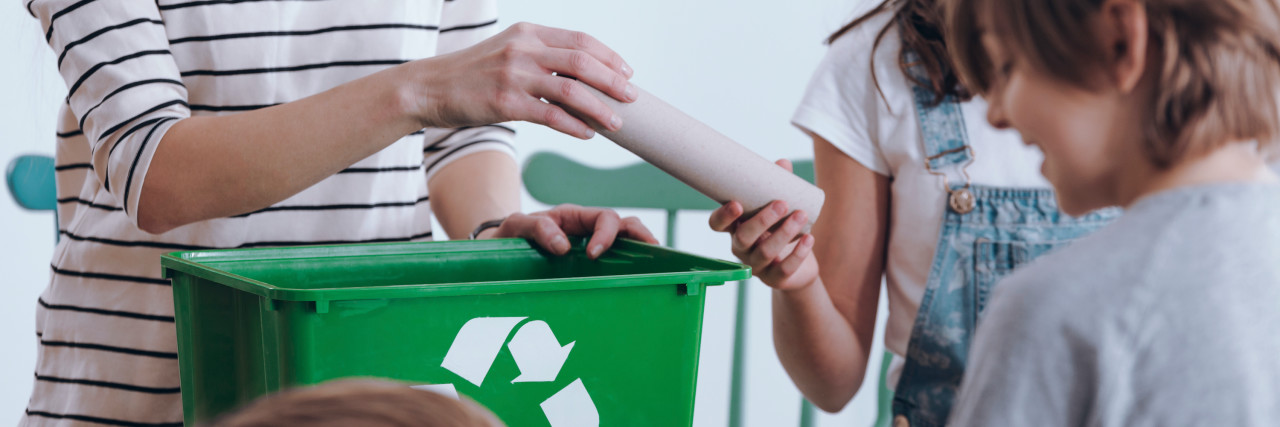We’re now part of a world which is growing in its awareness of sustainable living and the need to empower our children with the knowledge to do the same. Learn how to live eco-friendly lives with these five easy sustainable living examples designed to show you how to live a greener, more sustainable lifestyle. Here’s how to help create a better society for you and your children; let’s go!
GOING GREEN TIPS: FIVE WAYS TO TEACH YOUR CHILDREN ABOUT ECO-FRIENDLY LIVING
Read on for five simple tips to teach your children how to live a greener life.
RUBBISH CHORES
No, not chores they hate, chores involving organising your waste! Get plastic smart and have a look at these fun activities to challenge the whole family.
Create individual bins and boxes.
Get your children to help decorate and label each one to separate plastic bottle recycling, glass, paper, general waste, food waste and more.
Teach your children which items need to go in each, such as products like Persil. We’re using bottles made from 50% recycled plastic that are 100% recyclable!
Introduce discussions about the benefits of recycling, including reducing the rubbish in landfill and our oceans.
If your local recycling plant doesn’t collect food waste, consider composting it instead. Make sure the items are compostable first, however!
GO FOR A WALK
Not only is this healthy and greener than driving, you could turn it into a ‘green team walk’! Take some gloves, a rubbish sack, and litter pickers if you have them. Gather up any rubbish you see out and about and teach your children sustainable living and the impact they can have on the earth.
This is a great way to spend time together outside in forests, parks, and nature trails, so that children can experience the value in protecting nature.
Talk about how our own actions can impact nature – cleaning up your own neighbourhood is a great way to start but so too is having these conversations when you’re out and about.
Make climate change part of the conversation, and how we can help in our communities to stop the negative consequences. More on this, below!
CHANGE UP YOUR DIET
This includes growing your own, shopping for locally sourced food and even eating less meat. Teach your children how to go greener and minimise food miles by:
Getting them to help to plant seeds, them and care for them as they grow.
Growing a variety of fruits, vegetables, herbs and even pretty flowers to brighten your home too.
If you don’t have the space at home, why not check out local allotments and take the children to care for and grow food there instead?
Swapping 2-3 meals a week to vegetarian or vegan alternatives such as veggie curries or meat-free lasagne.
Shopping at local butchers, greengrocers, bakers and more.
GET CRAFTY
There are so many ways to go green with recycled crafts.
Raid the recycling bin for a plastic bottle to make a homemade bird feeder.
Use offcuts of paper from other crafts to create new paper.
Make seed paper with scraps of paper and flower seeds... These make great eco-friendly gifts, or you can plant them and watch them grow yourself!
Use old towels to make reusable wipes.
Don’t bin that stained dress! Sew up some pretty napkins instead (a great crafty for older children to learn a new skill!).
CREATE YOUR OWN SCIENTIFIC EXPERIMENTS
This is a great, practical way to show children how pollution works. For example, teach them about water pollution:
Have two cups, filled approximately half-way with plain water.
Add a few drops of food colouring (fruit squash would work too!) to one of the cups.
Now, you can show them that by adding extra clean water, you can’t change it back, and if you add the coloured water to the second cup both become polluted.
Make this part of a broader curriculum about climate change. Use storytime as a chance to read books with your children on how to live a greener life. Talk about how to save water and energy in the home, and tune into documentaries about climate change that are suitable for the whole family.


